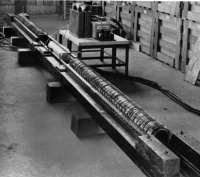Edwin Fitch Northrup by Ron Miller
From The Space Library
The Man Who Built the First Space Gun
Edward Fitch Northrup published a book called Zero to Eighty in 1937. He was a respected professor of “electrothermic engineering” at Princeton. Among his 104 patents was an induction furnace capable of producing temperatures up to 3600 degrees F.
In what must be one of the strangest sci-fi novels ever written, Northrup developed both theoretically and experimentally the idea of the modern “mass driver,” or electromagnetic gun. Northrup was 71 years old when he privately published this eccentric book, which contains descriptions, drawings and photographs of his working models, as well as a long technical appendix. What makes this book so odd is that Northrup chose to write it as the “autobiography” of the fictional “Akkad Pseudoman.” Since Pseudoman is supposed to have written the book in the year 2000, at the age of 80, the title is explained, if nothing else.
All of Northrup’s real-life experiments with the mass driver—or electric gun, as he calls it—are ascribed to Pseudoman. By using this literary device, Northrup not only described the machines and experiments he actually had carried out and patented, but was able to extend them in his imagination to their logical future conclusion: a manned spaceflight to the moon.
Electromagnetic guns---sometimes called “railguns”---are basically a series of electromagnets lined up in row. If they are energized and deenergized in sequence, like the light bulbs in a theater marquee, a kind of pulse or wave of magnetic energy flows along the line. This wave can carry an object and even accelerate it to tremendous speeds.

 Far left: Northrup launching a pair of tongs. Right: Projectile in a traveling magnetic wave gun.
Far left: Northrup launching a pair of tongs. Right: Projectile in a traveling magnetic wave gun.
Northrup began by describing the earliest experiments he worked on, which were actually carried out, for the most part, by his assistant, Theodore Kennedy. A photograph of one of these experiments shows a 4-inch diameter aluminum cylinder propped against the electric gun used to launch it. Even though the gun barrel is scarcely longer than the 28-inch projectile, it is able to accelerate it with a thrust of 700 pounds. In order to measure his guns’ performance and acceleration without loss or damage to his projectiles, Northrup simply placed two of his guns muzzle to muzzle; the projectile accelerated by one is braked by the other, using exactly the same amount of energy.
“Pseudoman” then proceeded to go on beyond the experiments actually performed by his real-life alter ego. Northrup’s fictional self plans to build an electrically launched vehicle that will travel to and circle the moon. Work is immediately begun in a full-scale manned vehicle. It is given emergency priority when it is learned that the Russians are also planning a moon flight of their own! Pseudoman sets a launch date in late 1960. The mass driver is not intended to provide all of the velocity necessary for the trip to the moon and back. The vehicle itself is a rocket. In a sense it is a three stage rocket in which the upper two are rocket-powered and the first stage is the mass driver, a stage that can be reused indefinitely. Pseudoman explains the necessity of using the gun, as opposed to using a rocket for the entire trip. There are no fuels in use at his time, he says, that would permit a realistic mass-ratio. “The moon will never be reached by a human being in a car propelled by rockets only, unless the dream of some scientists is realized whereby we will be able to release and control the almost limitless energy stored in atoms.”
 Northrup's diagram of his moon rocket.
Northrup's diagram of his moon rocket.
NASA has embraced the electromagnetic launching system for any number of potential uses in space exploration. For instance, it is is seriously studying the possibility of using a rail gun as a potential launch system, just as Northrup suggested. Stan Starr, branch chief of the Applied Physics Laboratory at Kennedy Space Center, says that the idea doesn’t require any new technology to be developed. “All of these are technology components that have already been developed or studied,” he said. “We’re just proposing to mature these technologies to a useful level, well past the level they’ve already been taken.”
 Electromagnetic launcher depicted in "The Moon Conquerors," by R.H. Romans, 1930
Electromagnetic launcher depicted in "The Moon Conquerors," by R.H. Romans, 1930
An early NASA proposal echoed Zero to Eighty in that it would use an electromagnetic launcher as a booster for a scramjet-propelled aircraft. Other uses NASA has suggested have included using electromagnetic cannons to launch spacecraft and materials from the surface of the moon (an idea that was a major plot device in Heinlein’s The Moon is a Harsh Mistress) and for steering asteroids into new orbits.

